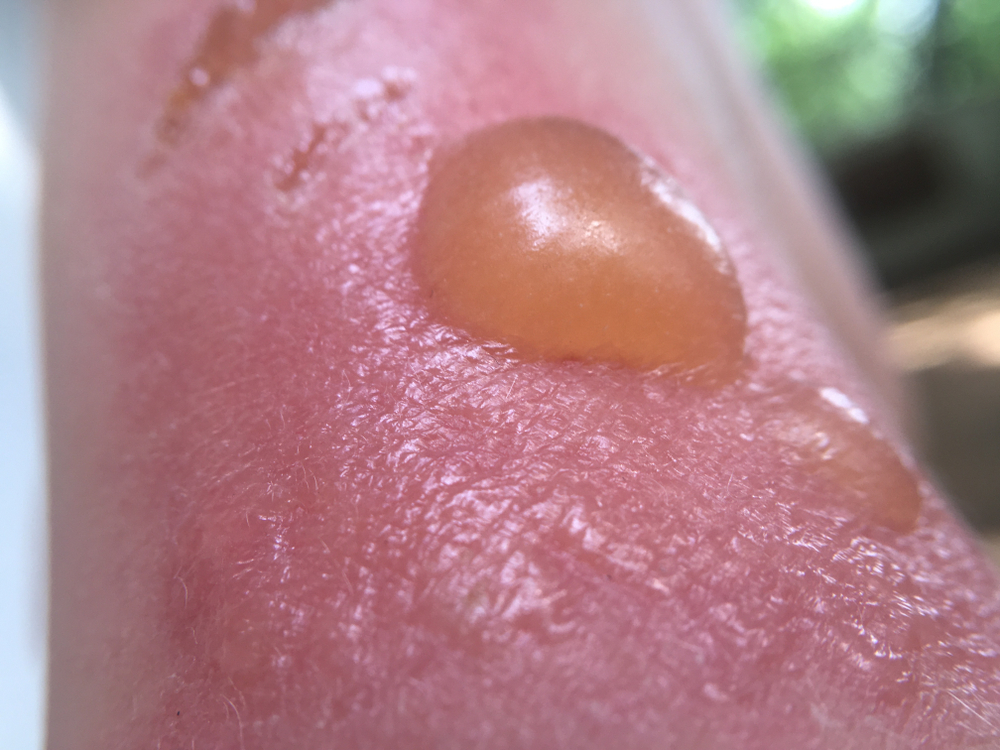If you find yourself with blisters after a particularly bad sunburn, take a deep breath. Don't be too hard on yourself. Sun blisters can happen to anyone—even when you have the best intentions.
Still, sunburn blisters need a little extra attention to heal properly. Read on to learn how to treat sunburn blisters and why they happen so you can recover as quickly as possible and avoid them in the future.
Understanding Sun Blisters
You're probably familiar with typical sunburn: red, painful skin that develops in areas that were exposed to the sun's ultraviolet (UV) rays. Sunburns occur when UV rays damage your skin's outermost layer, causing a first-degree sunburn. But when UV rays penetrate deeper into the skin, causing a second-degree sunburn, you may experience sun blisters.
What They Are
Sun blisters form over severely damaged skin to protect it from infection. These blisters are filled with a serum containing a combination of water and proteins, which come from the surrounding skin tissue and small blood vessels. Sunburn blisters usually develop anywhere from a few hours to a day after the sun exposure, and they can last for a week or longer.
Sun blisters are more than just a short-term concern, though. Research shows that having one blistering sunburn when you're young more than doubles your chance of developing melanoma in the future.
Who Can Get Them
Increased melanin (skin pigment) helps protect the skin from UV damage, so blisters are more likely to develop in fairer skin. But sun blisters can also happen in people with darker skin tones in the case of a really bad sunburn. That's why it's important to find a sunscreen you can use every day, no matter what your complexion is.
For example, EltaMD UV Clear Broad-Spectrum SPF 46 comes in tinted and untinted formulas and addresses a range of skin concerns, including rosacea, hyperpigmentation, and acne.
How They Feel
Sun blisters can be painful to the touch, and they can also feel itchy. The surrounding skin may be red, swollen, and tender.
If you experience fever, chills, vomiting, or dizziness along with sun blisters, it's time to get medical help. These symptoms could be signs of sun poisoning, which is an extreme type of sunburn that can lead to serious dehydration.
How to Treat Sunburn Blisters
Sunburn blisters can take a week or longer to heal. Severe cases can cause discoloration that may take months to resolve or even result in permanent scarring. Follow these tips to help your skin heal as quickly as possible and reduce the risk of these complications:
Leave Them Intact
An intact (or unbroken) blister acts like a natural bandage that helps protect and heal damaged skin. So, don't pop or pick at any blisters. Damaging blisters may slow down the healing process and increase your risk of scarring or infection.
Cool the Area
Keep the area around sunburn blisters cool by holding a cool compress to your skin or taking a cool shower. Just don't put ice directly on the sunburn, which can cause more damage.
Keep Exposed Blisters Clean
If a blister pops on its own, don't panic (and don't pick at the skin!). Wash the area with a mild cleanser and cover it with a nonstick bandage.
Reduce Swelling
Over-the-counter medications like ibuprofen can help reduce swelling and tenderness to bring you some relief.
Use Sun Protection
Keep the area covered to protect your sunburn from further sun exposure while it heals—even if it's a cloudy day or you think you'll only be out for a few minutes. Use tightly woven natural fabrics, like light cotton.
Stay Hydrated
Drink extra fluid to prevent dehydration and moisturize your skin with light creams or formulas that contain Aloe Vera. Avoid heavy products like petroleum jelly, which can trap heat.
Seek Medical Attention
If you have blisters over large areas of skin or if you develop signs of sun poisoning, like fever, chills, dizziness, or confusion, consult your healthcare provider right away. The same goes for signs of infection, like pus or red streaking.
Prevent Future Sunburn Blisters
Taking proper care of sunburn blisters will help them heal more quickly and avoid complications like hyperpigmentation and scarring. So, next time you're out enjoying the sun, apply sunscreen to all exposed skin and reapply every two hours to keep burns and blisters at bay. This protection will help keep your skin healthy and glowing from the inside out.

